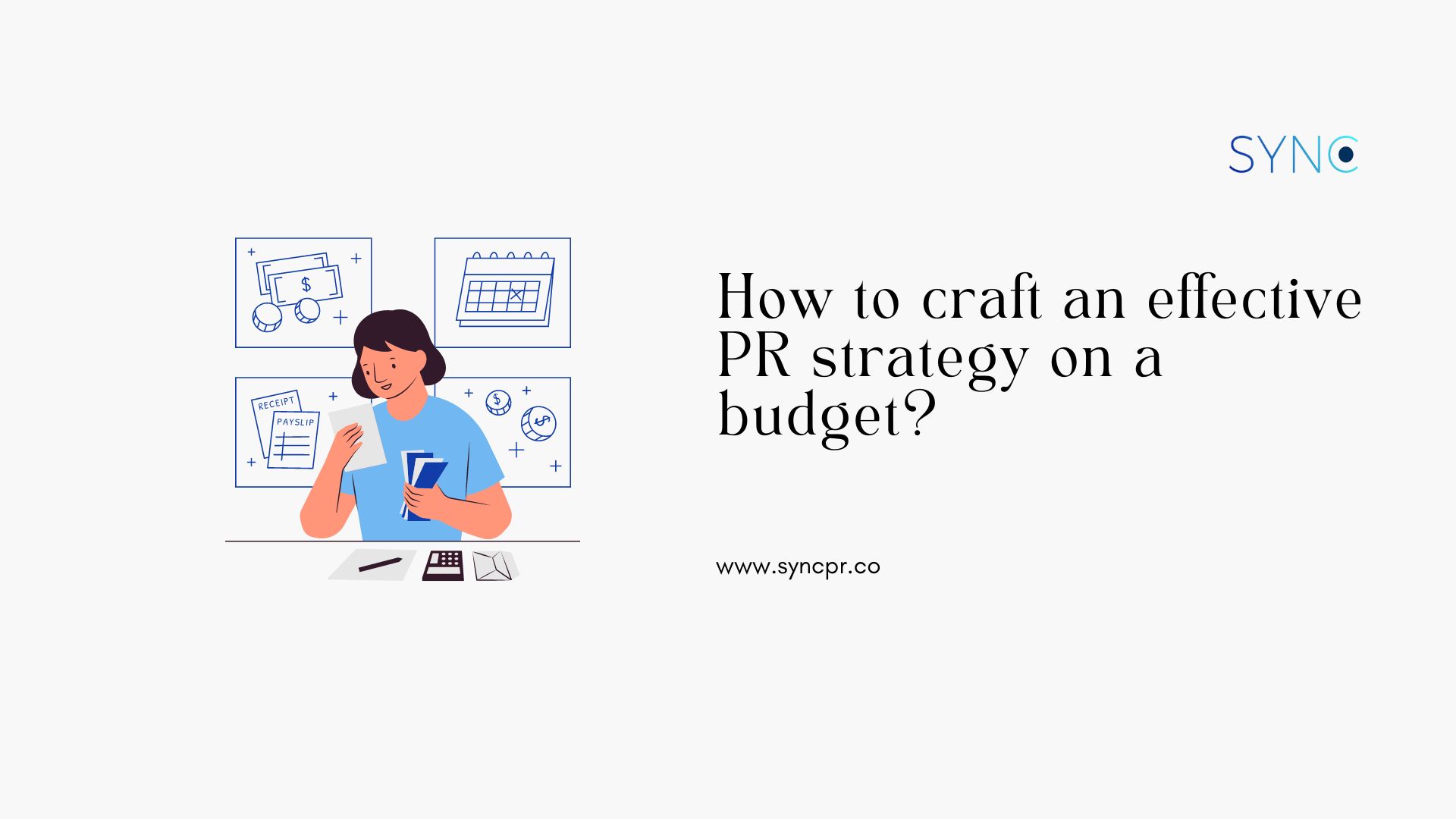Public relation is a powerful tool that can help SMEs and startups effectively communicate, establish credibility, and enhance their brand image. In a crowded marketplace, having a positive public perception can differentiate a business from its competitors.
A well-executed PR strategy can generate media coverage, increase brand visibility, attract potential customers, and ultimately drive business growth. By managing public perception and building relationships with various stakeholders, SMEs can foster trust, gain credibility, and position themselves as industry leaders.
When is the right time to start on your PR strategy?
The right time for SMEs and startups to start implementing PR strategy is often in the early stages of their development. As soon as a business has a clear value proposition, target audience, and basic marketing materials in place, it is ready to begin building its brand image through strategic PR initiatives.
Whether it’s launching a new product, announcing a milestone, or simply establishing thought leadership in the industry, PR plans can help create awareness and generate positive attention. By starting early, businesses can lay the foundation for long-term success and ensure that they are consistently communicating their key messages to the right audience.

While PR can deliver significant benefits, it can also be challenging for SMEs and startups to launch a comprehensive PR plan due to limited financial resources. Hiring a PR agency or professional may not be an option for everyone, and traditional methods such as print advertising and event sponsorships may not be viable options for businesses operating on a tight budget. However, it’s important to recognize that with creativity, resourcefulness, and a well-defined strategy, SMEs and startups can overcome these obstacles and effectively implement PR efforts without breaking the bank.
Define your target audience
The art of managing the dissemination of information between a person or an organisation such as a company, a governmental body, or a non-profit organisation and the general public is known as public relations (PR). With that, It is critical to define the term ‘public’ in this context. Stakeholders, employees, consumers, and potential customers can all be included. Individuals or groups of people might be your target audience, as can businesses or communities. Hence, defining the target audience is crucial in crafting an effective PR strategy.
By identifying the ideal customers or stakeholders, businesses can tailor their PR efforts to resonate with this specific group and ensure their message reaches the right people. Here are key considerations for defining the target audience for an effective PR strategy:
- Demographics: Start by understanding the demographic characteristics of your target audience. This includes factors such as age, gender, location, income level, education, and occupation. For example, if your SME offers tech-related services, your target audience might be young professionals aged 25-35, residing in urban areas, with a higher level of education and disposable income.
- Preferences: Determine the preferences, interests, and behaviours of your target audience. This includes understanding their needs, desires, pain points, and motivations. Conduct market research, and surveys, or engage in social listening to gather insights.
- Communication Channels: Identify the preferred communication channels and media consumption habits of your target audience. This includes online platforms, social media networks, industry-specific forums, blogs, or traditional media outlets.
By understanding the demographics, preferences, and communication channels of your target audience, you can tailor your PR strategy to effectively reach and engage with them. This allows you to craft messages that resonate, choose appropriate channels for distribution, and create content that speaks directly to their interests and needs. It’s important to regularly review and update your understanding of the target audience as market dynamics evolve and customer preference change.
Build relationships with the media is key to a good PR strategy
Any Pr strategy is not worthwhile if it does not yield good media relations. Building strong media relationships is vital for SMEs and startups in Malaysia, even with limited budgets. Without building media ties, public relations would become a one-sided discourse that would be ineffective. Start by identifying journalists, bloggers, and influencers covering relevant topics, and personalise your communication to show value and respect for their expertise. Provide newsworthy content in press releases and pitches, highlighting unique aspects of your business that resonate with their audience.


A global study by PRWeek found that 82% of journalists said that they are more likely to cover a story if it is unique and different from other stories they have seen. Proactively pitch story ideas and expert commentary to relevant media outlets in Malaysia. Provide expert opinions, or share success stories related to your business. This not only helps in generating media coverage but also enhances your brand’s credibility and visibility. Offering exclusive insights and collaboration opportunities, such as access to data or expert opinions, strengthens relationships and creates mutually beneficial outcomes.
Remember that building media relationships takes time, so maintain regular communication, share updates, and express gratitude for the coverage received. Engage with their content and establish yourself as a reliable source of information. As long as you keep your online press kit up to date, the publicist will have the materials they need to fulfil press requests. That attention to the demands of the media, as well as the ability to supply information on short notice, serve as important relationship builders for PR firms and the press. By actively cultivating these relationships, businesses can overcome budget constraints and achieve meaningful PR results. Positive media coverage and increased brand visibility contribute to awareness, credibility, and the overall growth and success of SMEs and startups, and can only be achieved with an effective PR strategy.
Leveraging social media
Leveraging online platforms is perhaps one of the best PR strategies for a brand to maximise its reach and increase brand visibility, especially when operating on a limited budget. By taking advantage of digital resources rather than print resources, you can cut down drastically on printing and shipping costs while still reaching a broad audience.
By capitalising on cost-effective online platforms, businesses can effectively engage with their target audience, share valuable content, and promote their brand. Social media channels such as Facebook, Instagram, and LinkedIn offer an opportunity to connect directly with audience and must be a part of any PR strategy. Establish a strong presence on these platforms by creating business pages or profiles, optimising them with compelling descriptions and visuals, and regularly updating them with engaging content. According to HubSpot, platforms like Twitter are a simple and cost-effective way to raise brand awareness, generate buzz, and position oneself as a brand.
Develop a content calendar to ensure consistent and regular updates, offering a mix of informative blog posts, visually appealing infographics, engaging videos, and customer testimonials. Actively engage with the audience by responding to comments, messages, and inquiries, fostering meaningful interactions. Collaborating with influencers or micro-influencers who align with your brand can amplify your reach and credibility. Every social media influencer has a distinct selling point. And, they generally tailor their message to their particular brand. Additionally, monitoring and measuring performance using analytics tools enables businesses to gain insights, optimise strategies, and improve results over time.
Publish thought leadership content
Publishing high-quality content is one of the finest approaches and an excellent PR strategy for establishing oneself as an expert to improve brand recognition in the industry. Thought leadership content goes beyond simple information – it provides thought-provoking ideas that the target audience cannot discover anywhere else. By sharing valuable insights and knowledge, businesses can position themselves as industry leaders.
PR agencies in Malaysia must leverage the power of platforms like LinkedIn Pulse and Medium to publish articles that showcase your expertise. Craft well-researched, informative, and engaging content that addresses industry trends and challenges, and provides practical solutions. Optimise your articles with relevant keywords and share them on your social media channels to broaden your reach.
Besides LinkedIn Pulse and Medium, explore other free content publishing sites to amplify your reach. Look for platforms that cater to your target audience and industry. Submit high-quality articles, case studies, or whitepapers that offer valuable insights and actionable advice. Be sure to include links to your website or relevant landing pages to drive traffic and generate leads. Engage with your audience by answering questions on Quora related to your industry. Monitor relevant topics and provide well-thought-out responses that showcase your expertise. Include a link to your website or relevant content to drive traffic and encourage further engagement.
You can also sign up to contribute to reputable publications like Entrepreneur or Forbes. If your pitches are approved, you’ll enjoy high-authority backlinks to your website. However, don’t forget about smaller blogs or websites in your industry. Pitching to a smaller site may be an easier way to get your foot in the door and get in front of your target audience.
Hiring an agency vs handling PR in-house
When it comes to PR for SMEs and startups in Malaysia, the choice between hiring an agency or handling PR in-house requires careful consideration. Both options have their merits. Hiring an agency offers the expertise of experienced professionals who can identify newsworthy angles and craft effective pitches, while in-house PR allows for a deeper understanding of the business and the ability to uncover unique stories. When pitching to smaller, niche publications and blogs, agencies may have established relationships, but in-house teams can leverage their knowledge of the media landscape to directly approach relevant outlets.
Simply said, PR firms are significantly more likely to have access to a richer and more knowledgeable background and are thus more well-equipped to help create a well-laid PR strategy. A PR firm is in a much better position than an in-house team to keep you on the cutting edge, especially for businesses in dynamic, fiercely competitive industries. Hiring a public relations firm will put you in touch with senior, skilled, and experienced creatives who excel at what they do. On the other hand, advanced technologies now allow an in-house team to perform things they couldn’t do before, such as creating, sending, and tracking email campaigns, identifying the finest media contacts, generating expert-level press releases, and maintaining an online newsroom.
Ultimately, the decision depends on factors such as budget, expertise, and resources. Regardless of the chosen approach, a strategic PR campaign that aligns with business goals and targets niche publications can generate media coverage, enhance brand visibility, and contribute to the success of SMEs and startups in Malaysia.
Are you an SME or startup in Malaysia looking to enhance your brand visibility and generate positive media coverage without breaking the bank? SYNC PR specialises in offering cost-effective PR services tailored to the needs of small businesses. Take the first step towards boosting your brand’s reputation and gaining media attention.
Contact us hello(@)syncpr.co for a consultation and let us help you craft an effective PR strategy that fits your budget and drives your business forward.

